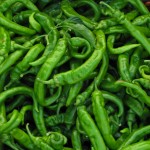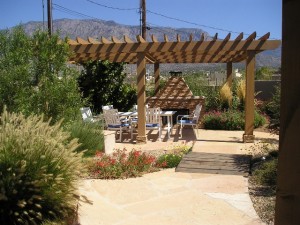High Desert Landscaping Tips
Red Twig Studio as featured on LandscapingNetwork.com
The biggest landscaping challenge in Albuquerque is the lack of water. “With rainfall at a new low, we must be wise about our landscape choices,” says Amy. Check out her tips below for more information on how to make the most of your outdoor spaces while being good stewards of our resources.
DO’S:
- Do take advantage of the City of Albuquerque’s xeriscape rebate program. Save money and water by removing your turf grass and xeriscaping your yard to get a rebate on your water bill.
- Since spring is windy here in Albuquerque, do think about planting a hedge or a grouping of trees to create a windbreak. Evergreens are ideal in this situation. Think pines or curl leaf mountain mahogany. Always stake new trees for the first couple of years so roots establish and are able to withstand future spring winds.
- Do grow chiles. With NM being the green chile capital, we have
 a perfect environment for these spicy little gems. You’ll be amazed by the variety of chiles available locally for spring planting, from our signature green to multiple colors of bell peppers to little orange habaneros, the hottest of the bunch, and everything in between. Go a step further by adding tomatoes, onions and cilantro for a fresh salsa garden.
a perfect environment for these spicy little gems. You’ll be amazed by the variety of chiles available locally for spring planting, from our signature green to multiple colors of bell peppers to little orange habaneros, the hottest of the bunch, and everything in between. Go a step further by adding tomatoes, onions and cilantro for a fresh salsa garden. - Take advantage of our late summer monsoons by installing rain barrels, or creating a natural arroyo (swale) that flows through the yard delivering any extra water to plants in need.
- Albuquerque has an ideal climate for outdoor living. Do think about adding a fire pit to your patio so you can enjoy the clear winter nights, or a recirculating fountain, shade tree or pergola to keep you feeling cool in summer.
- Do realize that mulch is critical. Whether bark, pecan shells or gravel, mulch helps keep the soil cool, insulate plant roots and prevents water from evaporating too quickly.
- Do install a good drip irrigation system. This is really critical for the success of your xeriscape. Drip is the most efficient watering system in the high desert. In warmer months try to irrigate around 5 am so roots have time to absorb water before daytime heat is blazing. A timer and drip system will also add value to your home.
- Do plant bulbs in late fall. In Albuquerque we have a good winter chill so we are able to plant tulips, daffodils and even fruit trees that are unable to grow in the heat of the low desert.
DON’TS:
- Don’t ZEROscape. It’s great to remove the grass and save on water, but a yard full of gravel with no plants just heats up your immediate environment. If you do remove your grass, be sure to cover the ground again right away or the existing trees and shrubs that were blanketed by the turf will get sunburned roots and may end up seriously damaged.
- Don’t be fooled into thinking that
 xeriscaping is all cactus and yuccas. A xeriscape can actually be quite lush when the right plants are chosen and irrigated and maintained correctly.
xeriscaping is all cactus and yuccas. A xeriscape can actually be quite lush when the right plants are chosen and irrigated and maintained correctly. - Don’t water shallowly. It is so important to water deeply every few days, rather than shallowly everyday. This helps establish the deep roots a plant will need in times of drought or if your irrigation system breaks temporarily.
- Don’t assume you can cut back on irrigation of a newly installed xeriscape within first few months. It takes plants at least 2 years to establish themselves before you should even think about cutting back on the amount of water they receive. Remember that plants are not instantly xeric, they need sufficient time to establish.
- Don’t be afraid to plant trees, sometimes people don’t realize they are appropriate for xeriscaping but they play a vital role. They provide shade for houses, patios and cars, and allow sun to stream through in winter to warm things up, saving energy. Try a chinese pistache for some shade, and a desert willow for a low water use ornamental.
- Don’t plant non-native species that aren’t adapted to Albuquerque’s climate. Such plants need fertilizer and heavier watering to keep them on track. Not receiving these causes them to become stressed, and that weakens the cells of the plant, attracting insects we don’t want, and the combination inevitably causes the death of the plant. Instead, plant natives that are adapted to our area, grow in our soil without fertilizer, are used to drier conditions, and attract the right insects.

